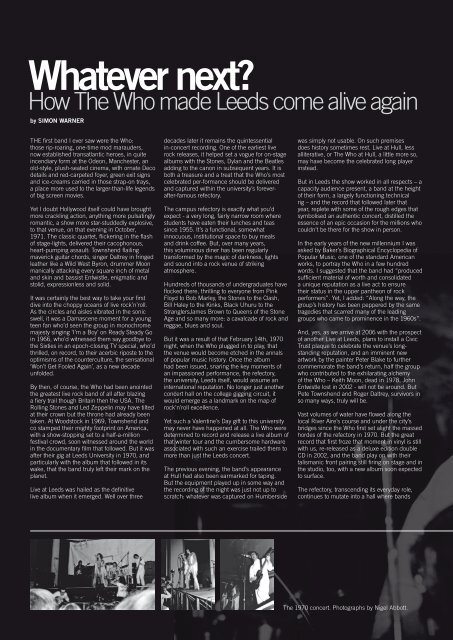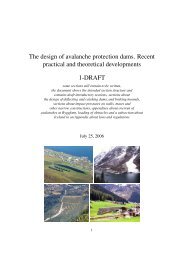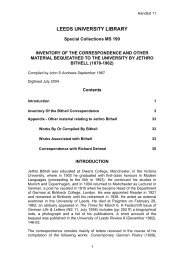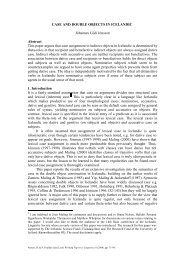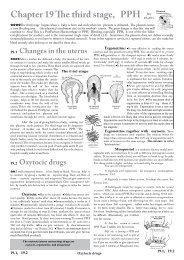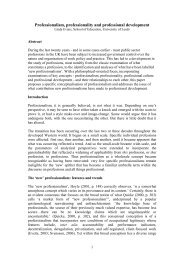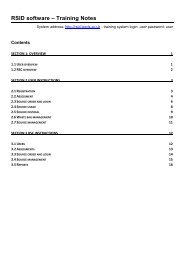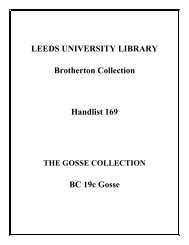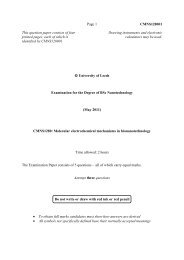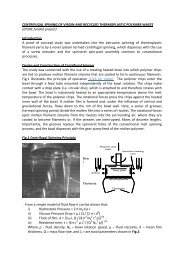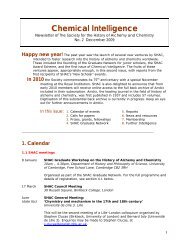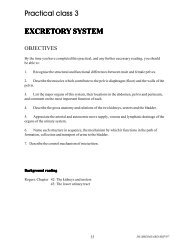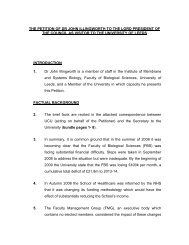You also want an ePaper? Increase the reach of your titles
YUMPU automatically turns print PDFs into web optimized ePapers that Google loves.
Whatever next?<br />
How The Who made <strong>Leeds</strong> come alive again<br />
by SIMON WARNER<br />
THE first band I ever saw were the Who:<br />
those rip-roaring, one-time mod marauders,<br />
now established transatlantic heroes, in quite<br />
incendiary form at the Odeon, Manchester, an<br />
old-style, plush-seated cinema, with ornate Deco<br />
details and red-carpeted foyer, green exit signs<br />
and ice-creams carried in those strap-on trays,<br />
a place more used to the larger-than-life legends<br />
<strong>of</strong> big screen movies.<br />
Yet I doubt Hollywood itself could have brought<br />
more crackling action, anything more pulsatingly<br />
romantic, a show more star-studdedly explosive,<br />
to that venue, on that evening in October,<br />
1971. The classic quartet, flickering in the flash<br />
<strong>of</strong> stage-lights, delivered their cacophonous,<br />
heart-pumping assault: Townshend flailing<br />
maverick guitar chords, singer Daltrey in fringed<br />
leather like a Wild West Byron, drummer Moon<br />
manically attacking every square inch <strong>of</strong> metal<br />
and skin and bassist Entwistle, enigmatic and<br />
stolid, expressionless and solid.<br />
It was certainly the best way to take your first<br />
dive into the choppy oceans <strong>of</strong> live rock’n’roll.<br />
As the circles and aisles vibrated in the sonic<br />
swell, it was a Damascene moment for a young<br />
teen fan who’d seen the group in monochrome<br />
majesty singing ‘I’m a Boy’ on Ready Steady Go<br />
in 1966, who’d witnessed them say goodbye to<br />
the Sixties in an epoch-closing TV special, who’d<br />
thrilled, on record, to their acerbic riposte to the<br />
optimisms <strong>of</strong> the counterculture, the sensational<br />
‘Won’t Get Fooled Again’, as a new decade<br />
unfolded.<br />
By then, <strong>of</strong> course, the Who had been anointed<br />
the greatest live rock band <strong>of</strong> all after blazing<br />
a fiery trail though Britain then the USA. The<br />
Rolling Stones and Led Zeppelin may have tilted<br />
at their crown but the throne had already been<br />
taken. At Woodstock in 1969, Townshend and<br />
co stamped their mighty footprint on America,<br />
with a show-stopping set to a half-a-million<br />
festival crowd, soon witnessed around the world<br />
in the documentary film that followed. But it was<br />
after their gig at <strong>Leeds</strong> <strong>University</strong> in 1970, and<br />
particularly with the album that followed in its<br />
wake, that the band truly left their mark on the<br />
planet.<br />
Live at <strong>Leeds</strong> was hailed as the definitive<br />
live album when it emerged. Well over three<br />
decades later it remains the quintessential<br />
in-concert recording. One <strong>of</strong> the earliest live<br />
rock releases, it helped set a vogue for on-stage<br />
albums with the Stones, Dylan and the Beatles<br />
adding to the canon in subsequent years. It is<br />
both a treasure and a treat that the Who’s most<br />
celebrated per-formance should be delivered<br />
and captured within the university’s foreverafter-famous<br />
refectory.<br />
The campus refectory is exactly what you’d<br />
expect - a very long, fairly narrow room where<br />
students have eaten their lunches and teas<br />
since 1955. It’s a functional, somewhat<br />
innocuous, institutional space to buy meals<br />
and drink c<strong>of</strong>fee. But, over many years,<br />
this voluminous diner has been regularly<br />
transformed by the magic <strong>of</strong> darkness, lights<br />
and sound into a rock venue <strong>of</strong> striking<br />
atmosphere.<br />
Hundreds <strong>of</strong> thousands <strong>of</strong> undergraduates have<br />
flocked there, thrilling to everyone from Pink<br />
Floyd to Bob Marley, the Stones to the Clash,<br />
Bill Haley to the Kinks, Black Uhuru to the<br />
StranglersJames Brown to Queens <strong>of</strong> the Stone<br />
Age and so many more: a cavalcade <strong>of</strong> rock and<br />
reggae, blues and soul.<br />
But it was a result <strong>of</strong> that February 14th, 1970<br />
night, when the Who plugged in to play, that<br />
the venue would become etched in the annals<br />
<strong>of</strong> popular music history. Once the album<br />
had been issued, snaring the key moments <strong>of</strong><br />
an impassioned performance, the refectory,<br />
the university, <strong>Leeds</strong> itself, would assume an<br />
international reputation. No longer just another<br />
concert hall on the college gigging circuit, it<br />
would emerge as a landmark on the map <strong>of</strong><br />
rock’n’roll excellence.<br />
Yet such a Valentine’s Day gift to this university<br />
may never have happened at all. The Who were<br />
determined to record and release a live album <strong>of</strong><br />
that winter tour and the cumbersome hardware<br />
associated with such an exercise trailed them to<br />
more than just the <strong>Leeds</strong> concert.<br />
The previous evening, the band’s appearance<br />
at Hull had also been earmarked for taping.<br />
But the equipment played up in some way and<br />
the recording <strong>of</strong> the night was just not up to<br />
scratch: whatever was captured on Humberside<br />
was simply not usable. On such premises<br />
does history sometimes rest. Live at Hull, less<br />
alliterative, or The Who at Hull, a little more so,<br />
may have become the celebrated long player<br />
instead.<br />
But in <strong>Leeds</strong> the show worked in all respects – a<br />
capacity audience present, a band at the height<br />
<strong>of</strong> their form, a largely functioning technical<br />
rig – and the record that followed later that<br />
year, replete with some <strong>of</strong> the rough edges that<br />
symbolised an authentic concert, distilled the<br />
essence <strong>of</strong> an epic occasion for the millions who<br />
couldn’t be there for the show in person.<br />
In the early years <strong>of</strong> the new millennium I was<br />
asked by Baker’s Biographical Encyclopedia <strong>of</strong><br />
Popular Music, one <strong>of</strong> the standard American<br />
works, to portray the Who in a few hundred<br />
words. I suggested that the band had “produced<br />
sufficient material <strong>of</strong> worth and consolidated<br />
a unique reputation as a live act to ensure<br />
their status in the upper pantheon <strong>of</strong> rock<br />
performers”. Yet, I added: “Along the way, the<br />
group’s history has been peppered by the same<br />
tragedies that scarred many <strong>of</strong> the leading<br />
groups who came to prominence in the 1960s”.<br />
And, yes, as we arrive at 2006 with the prospect<br />
<strong>of</strong> another Live at <strong>Leeds</strong>, plans to install a Civic<br />
Trust plaque to celebrate the venue’s longstanding<br />
reputation, and an imminent new<br />
artwork by the painter Peter Blake to further<br />
commemorate the band’s return, half the group<br />
who contributed to the exhilarating alchemy<br />
<strong>of</strong> the Who – Keith Moon, dead in 1978, John<br />
Entwistle lost in 2002 - will not be around. But<br />
Pete Townshend and Roger Daltrey, survivors in<br />
so many ways, truly will be.<br />
Vast volumes <strong>of</strong> water have flowed along the<br />
local River Aire’s course and under the city’s<br />
bridges since the Who first set alight the massed<br />
hordes <strong>of</strong> the refectory in 1970. But the great<br />
record that first froze that moment in vinyl is still<br />
with us, re-released as a deluxe edition double<br />
CD in 2002, and the band play on with their<br />
talismanic front pairing still firing on stage and in<br />
the studio, too, with a new album soon expected<br />
to surface.<br />
The refectory, transcending its everyday role,<br />
continues to mutate into a hall where bands<br />
The 1970 concert. Photographs by Nigel Abbott.


